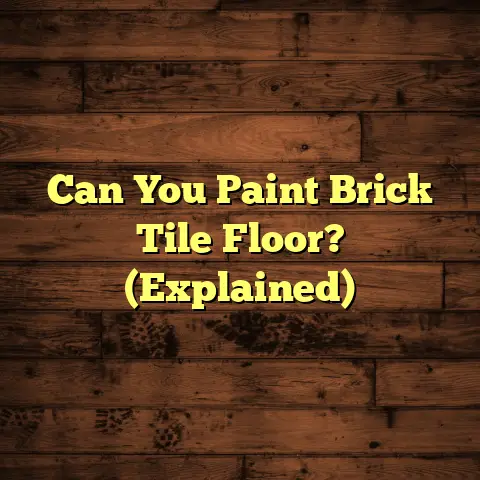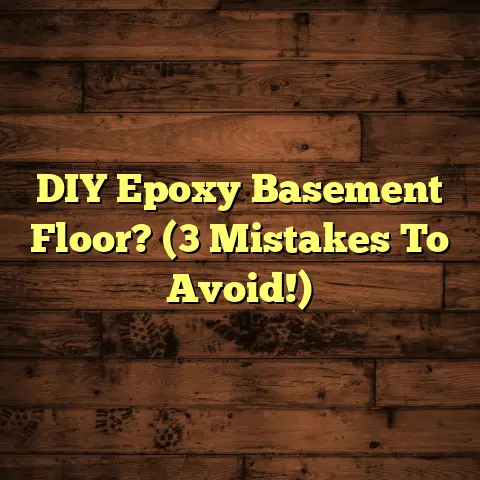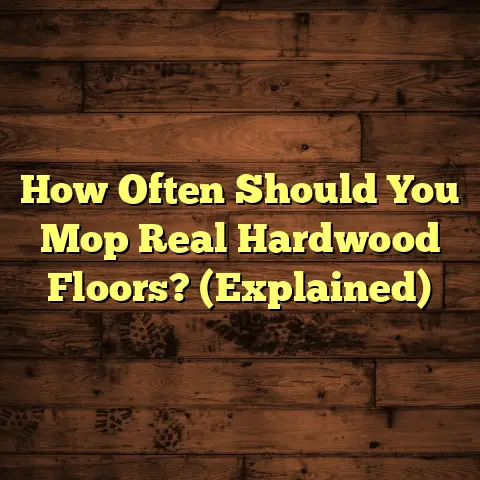Creaking Floors? (1 Sign of Big Trouble!)
Now, I get it. You’ve probably seen those gorgeous homes in magazines, right? The ones with the open floor plans and gleaming hardwood floors?
Trendsetters are all about that sleek, modern look. Hardwood, engineered wood, even reclaimed wood – it’s all about creating a space that feels warm and sophisticated. It screams, “I have taste!”
But let’s be real. A beautiful floor is only as good as its foundation (literally!). We can’t just focus on the aesthetics; we need to think about functionality too. And that’s where those pesky creaks come in.
Section 1: Understanding Creaking Floors
So, what are creaking floors? Simply put, it’s that annoying squeak, groan, or crack you hear when you walk across certain spots in your house.
Why does it happen? Well, imagine two pieces of wood rubbing together. That friction creates noise. That’s essentially what’s happening under your feet.
Think of it like this: It’s like an old door hinge that needs some WD-40. The floorboards are moving against each other, or against the subfloor.
Usually, it’s due to changes in humidity and temperature. Wood expands and contracts, which loosens things up. Sometimes it’s loose nails or even deeper structural issues. It’s not always a simple fix, sadly.
Section 2: The Anatomy of a Floor
To really understand why floors creak, we need to talk about what’s under your beautiful flooring. It’s like understanding the skeleton before you admire the skin.
A typical floor system has several layers:
-
Joists: These are the horizontal beams that support the entire floor structure. Think of them as the backbone. They transfer the floor load to the foundation.
-
Subfloor: This is the layer directly on top of the joists. It’s usually made of plywood or OSB (oriented strand board). It provides a solid surface for the finished flooring.
-
Finished Flooring: This is the pretty stuff you see – hardwood, laminate, tile, carpet, etc.
Each of these parts plays a crucial role. If one component is compromised, it can affect the entire floor.
For example, if a joist is damaged, it can cause the subfloor to sag. If the subfloor isn’t properly secured, it can cause the finished floor to move and creak. It’s all interconnected.
Section 3: Causes of Creaking Floors
Okay, let’s dive into the nitty-gritty. What are the most common culprits behind those creaks?
Moisture Issues
This is a big one. Wood is a natural material, and it’s constantly reacting to its environment. High humidity causes wood to expand, and low humidity causes it to contract.
I’ve seen cases where a leaky pipe or a poorly ventilated crawl space has led to severe moisture problems, causing widespread creaking.
Age and Wear
Let’s face it, everything deteriorates over time. Older homes are especially prone to creaking floors.
The wood dries out, fasteners loosen, and the subfloor can start to delaminate. Plus, years of foot traffic take their toll.
Think of it like an old pair of shoes. The soles start to separate from the uppers, and they make noise when you walk.
Poor Installation
This is where I get fired up. As a professional, I take pride in doing things right. But I’ve seen some truly awful flooring installations.
Improper nailing, insufficient adhesive, and uneven subfloors can all lead to creaking. Sometimes, the installer simply didn’t leave enough space for expansion and contraction.
I once had a client who hired the cheapest contractor they could find. The floor looked beautiful at first, but within a few months, it was creaking like crazy. They ended up having to rip it all out and start over.
Structural Problems
This is the scariest one. Sometimes, creaking floors aren’t just a cosmetic issue; they’re a sign of a bigger problem.
Foundation issues, sagging joists, and other structural problems can cause the floor to shift and creak. These problems can be expensive to fix, and they can even compromise the safety of your home.
If you suspect a structural issue, get it checked out by a qualified professional ASAP.
Section 4: Why Creaking Floors Can Be a Sign of Big Trouble
Okay, so you know why floors creak. But why should you care? It’s just a little noise, right?
Wrong. Creaking floors can be a warning sign of serious underlying problems.
Potential Structural Damage
Persistent creaks can indicate weakened joists or a compromised foundation. If the floor is sagging or uneven, that’s a major red flag.
Ignoring these signs can lead to more significant damage down the road. You could end up with a collapsing floor, which is obviously a huge safety hazard.
Pest Infestations
Certain pests, such as termites and carpenter ants, can weaken flooring and cause creaking. These pests tunnel through the wood, creating hollow spaces that cause the floor to flex and make noise.
If you see signs of pest activity, such as sawdust or droppings, call an exterminator immediately.
Neglect and Maintenance
Ignoring creaking floors can lead to more significant damage and costly repairs down the line. The longer you wait, the worse the problem will become.
Think of it like a small leak in your roof. If you don’t fix it, it will eventually lead to water damage, mold, and structural problems.
Section 5: Real-Life Case Studies
Let me share a few stories from my own experience. These are real people who experienced creaking floors and the consequences that followed.
Case Study 1: The Water Leak
I had a client, let’s call her Sarah, who had beautiful hardwood floors in her kitchen. One day, she noticed a slight creak near the sink. She didn’t think much of it, but over time, the creak got louder and more frequent.
Eventually, she called me in to take a look. I discovered a slow leak under the sink that had been dripping onto the subfloor for months. The subfloor was rotten, and the joists were starting to show signs of water damage.
We had to replace the subfloor, repair the joists, and install new hardwood flooring. The whole project cost several thousand dollars. If Sarah had addressed the problem sooner, she could have saved a lot of money and hassle.
Case Study 2: The Termite Infestation
Another client, John, had creaking floors throughout his entire house. He assumed it was just due to the age of the home.
But when I inspected the floors, I found evidence of termite damage. The termites had been eating away at the joists and subfloor, causing the floors to sag and creak.
We had to call in an exterminator to treat the termites. Then, we had to replace a significant portion of the joists and subfloor. It was a major undertaking.
Case Study 3: The DIY Disaster
I once had a homeowner, Mark, who decided to install laminate flooring himself. He thought he could save some money by doing it himself.
But he didn’t properly prepare the subfloor, and he didn’t use enough adhesive. Within a few weeks, the floor was creaking and buckling.
He ended up having to rip out the entire floor and hire a professional to do the job right. He learned the hard way that some things are best left to the experts.
Section 6: The Emotional Impact of Creaking Floors
Okay, let’s talk about something that often gets overlooked: the emotional impact of creaking floors.
It might sound silly, but living in a home with constant creaking can be incredibly stressful. It can disrupt your peace of mind, make it difficult to relax, and even affect your sleep.
Imagine trying to sneak into the kitchen for a midnight snack, only to have the floor announce your every move. Or trying to have a romantic evening, only to have the floor creak and groan every time you shift your weight.
It might seem like a minor annoyance, but over time, it can really wear you down.
Section 7: Conclusion
So, what’s the takeaway here? Don’t ignore those creaking floors! They might seem like a small problem, but they can be a sign of something much bigger.
Be attentive to the signs, and don’t hesitate to call a professional for an evaluation. It’s better to be safe than sorry.
By addressing the problem early, you can prevent further damage, save money on repairs, and protect the safety and longevity of your home.
Remember: Your home is your sanctuary. You deserve to live in a space that is comfortable, safe, and free from annoying creaks.
Call to Action
Now, I want to hear from you! Have you ever experienced creaking floors in your home? What did you do about it? Share your stories and tips in the comments below! Let’s create a community where we can all learn from each other.
I hope this article has been helpful. If you have any questions, feel free to ask. And if you’re in need of flooring services, don’t hesitate to reach out. I’m here to help!





